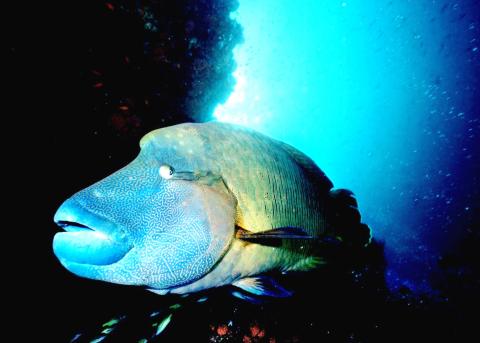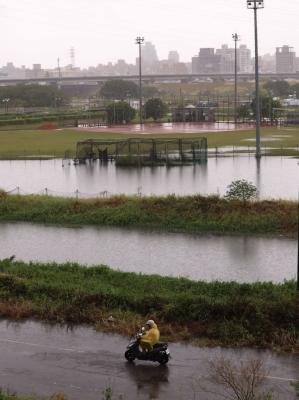Marine biologists and conservation groups yesterday launched a signature drive for a petition urging the government to add two endangered bulbous-head fish species to the protected species list.
The petition will ask the Council of Agriculture to add the Napoleonfish and the Bumphead Parrotfish onto the Schedule of Protected Species List under the Wildlife Conservation Act (野生動物保育法).
The Napoleonfish is also known as the humphead wrasse, and its name in Chinese means “dragon king fish.” The bumphead parrotfish — Bolbometopon muricatum — is also known as the double-headed parrotfish. Both species are slow growing and long-lived, with delayed reproduction and low rates of replenishment.

Photo provided by Taiwanese Coral Reef Society
“The number of these two fish species still left is lower than the number of Chinese white dolphins in the waters around Taiwan’s west coast,” Taiwanese Coral Reef Society (TCRS) chairperson Cheng Ming-shou (鄭明修) said.
TCRS secretary-general Chang Ming-lung (張銘隆) said that both the Napoleonfish and the bumphead parrotfish are considered giant species of the marine reef community, and they used to be quite common in the coral reefs near the shores of Taiwan.
However, they are now on the brink of extinction, after many years of unregulated harvesting by fishermen and spear fishing by recreational divers, he said.
“We estimate that there are only about 30 individuals of these two species left, which is less than the 66 recorded for the Chinese white dolphin in the Taiwan Strait,” he said.
“The Forestry Bureau held a meeting to discuss adding these two fish species to the Schedule of Protected Species List. However, Department of Fisheries officials thought there was insufficient data for assessment. So more data will need to be provided, and this issue will be put on the agenda of next month’s Wildlife Protection Advisory Committee meeting,” the head of the Forestry Bureau’s Protected Species Division, Guang Li-hao (管立豪), said.
It is quite alarming that it has been more than 10 years since a single Napoleonfish or bumphead parrotfish was sighted in the marine reef territories surrounding Taiwan and its offshore islands of Green Island, Lanyu (蘭嶼) and Penghu and recorded in the survey conducted by his organization, Chang said.
TCRS have sent letters to the Conservation Division of the Forestry Bureau, requesting to place Napoleonfish and bumphead parrotfish onto the Schedule of Protected Species List.
“My research programs focus on the waters around Kenting (墾丁) and the Pratas Islands (Dongsha Islands, 東沙群島). During my diving expeditions over the past decade, I have rarely spotted the Napoleonfish,” said Chen Cheng-ping (陳正平), a Taiwan Ocean Research Institute researcher.
Cheng, who is a researcher at the Biodiversity Research Center of Academia Sinica, said the Napoleonfish was the largest fish in the nation’s coral reef ecosystem, and can weigh up to 200kg.
However, due to overfishing, “most Napoleonfish have been eaten. We hardly see them anymore in the waters surrounding Taiwan,” he said.
“The bumphead parrotfish is easy prey for fishermen, because it has a fixed habitat and keeps regular sleeping hours,” Cheng said.
Both of these species are excellent attractions that pull in tourists and divers to renowned tourist spots in coastal recreational parks around the world and protected marine areas around tropical islands, he said.
“They are the star attractions and the real money-spinners for the marine tourist industry. Therefore, we urge the council to add these two ‘shining stars’ of the coral reef fishes to the protected species list. They should become attractions for marine recreation activities, and we should put them in the international spotlight,” Cheng said.

TRAFFIC SAFETY RULES: A positive result in a drug test would result in a two-year license suspension for the driver and vehicle, and a fine of up to NT$180,000 The Ministry of Transportation and Communications is to authorize police to conduct roadside saliva tests by the end of the year to deter people from driving while under the influence of narcotics, it said yesterday. The ministry last month unveiled a draft of amended regulations governing traffic safety rules and penalties, which included provisions empowering police to conduct mandatory saliva tests on drivers. While currently rules authorize police to use oral fluid testing kits for signs of drug use, they do not establish penalties for noncompliance or operating procedures for officers to follow, the ministry said. The proposed changes to the regulations require

The Executive Yuan yesterday announced that registration for a one-time universal NT$10,000 cash handout to help people in Taiwan survive US tariffs and inflation would start on Nov. 5, with payouts available as early as Nov. 12. Who is eligible for the handout? Registered Taiwanese nationals are eligible, including those born in Taiwan before April 30 next year with a birth certificate. Non-registered nationals with residence permits, foreign permanent residents and foreign spouses of Taiwanese citizens with residence permits also qualify for the handouts. For people who meet the eligibility requirements, but passed away between yesterday and April 30 next year, surviving family members

Taipei, New Taipei City, Keelung and Taoyuan would issue a decision at 8pm on whether to cancel work and school tomorrow due to forecasted heavy rain, Keelung Mayor Hsieh Kuo-liang (謝國樑) said today. Hsieh told reporters that absent some pressing reason, the four northern cities would announce the decision jointly at 8pm. Keelung is expected to receive between 300mm and 490mm of rain in the period from 2pm today through 2pm tomorrow, Central Weather Administration data showed. Keelung City Government regulations stipulate that school and work can be canceled if rain totals in mountainous or low-elevation areas are forecast to exceed 350mm in

China Airlines Ltd (CAL) yesterday morning joined SkyTeam’s Aviation Challenge for the fourth time, operating a demonstration flight for “net zero carbon emissions” from Taiwan Taoyuan International Airport to Bangkok. The flight used sustainable aviation fuel (SAF) at a ratio of up to 40 percent, the highest proportion CAL has achieved to date, the nation’s largest carrier said. Since April, SAF has become available to Taiwanese international carriers at Taipei International Airport (Songshan airport), Kaohsiung International Airport and Taoyuan airport. In previous challenges, CAL operated “net zero carbon emission flights” to Singapore and Japan. At a ceremony at Taoyuan airport, China Airlines chief sustainability